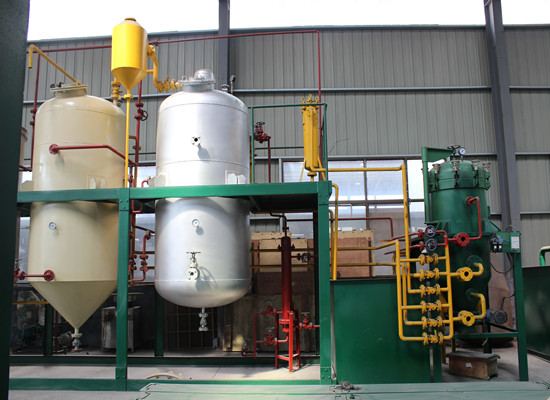
Palm oil is currently the second largest edible vegetable oil in the world. Palm planting costs are low and palm oil prices are low, so it has a strong competitiveness in the world edible oil market. So how can we get high-quality palm oil? Henan Zhongxing Company tells you: at first, you can get crude palm oil by pressing, and then by refining crude palm oil, you can get high-quality palm oil with different melting points.
Palm fruit bunch → palm oil press → crude palm oil → refining equipment → refined palm oil → fractionation equipment → 18℃, 24℃, 32℃
Matters needing attention during operation of palm oil refining equipment:
The purpose of oil refining in the oil refining process is to remove impurities and reach the standard of finished edible oil. The main process flow is: crude oil-degumming-neutralization-decolorization-deodorization-separation. Water is added for hydration and degumming, alkali is added for neutralization or steam distillation deacidification, adsorbent activated clay or activated carbon is added for decolorization, high temperature and negative pressure deodorization, and low boiling point volatiles that produce oil fume are removed.
The crude oil is filtered, and the crude oil acquired must be filtered to remove suspended particulate impurities and other impurities in order to proceed to the following production.
Degummed gums are phospholipids, sugars, protein mixtures, trace metals and other impurities. Degumming is the removal process of these impurities. The quality of the raw oil and fat determines the quality of the final product to a large extent. The gum in the raw oil and fat is an important factor affecting the quality of the oil. These impurities make the oil and the catalyst do not contact, thereby reducing the rate of cracking. Direct neutralization without degumming will make it difficult to operate and increase oil loss due to emulsification. Glue is also the cause of oil foaming, which affects the stability and color of the product. Negative Effects.
Neutralization and deacidification is a process that has a great impact on product quality and price. If there is a problem in the neutralization process, it will bring difficulties to the various processes after decolorization, and reduce product quality and yield. There are usually two methods for neutralization, namely physical and chemical methods. In principle, the physical refining method, that is, the gas-lifting distillation deacidification method, should be used as the selection process of oil refining. The chemical neutralization method is to neutralize the free in crude oil with sodium hydroxide. Fatty acid deacidification will produce soapstock and waste water.
Decolorization is one of the more important processes in the oil refining process. In addition to removing the pigment in the oil, it can also reduce the phospholipid content, peroxide value, soap content and metal ion content, thereby changing the color and luster of the oil. The flavor and accelerated oxidation stability provide good conditions for the further refinement, hydrogenation and deodorization of fats and oils.
To produce palm oil, deodorization is a very important step. In the oil deodorization process, in addition to the purpose of deodorization, the current focus is on achieving unit operation at low temperature and short time, inhibiting the production of trans fatty acids, reducing the loss of tocopherols, reducing polymerization, and reducing vitamins (A , D, E) decomposition. The temperature is 230-250, and the vacuum residual pressure is 6-8 mm Hg.
Fractionation is a special treatment for palm oil, that is, the temperature of palm oil is cooled to about 24°C and it takes time to keep it. The high melting point components will crystallize out, and they can be "separated" into three different types after secondary filtration. Melting point products, these three products are palm stearin with a melting point higher than 40°C, palm palm oil with a melting point of about 30°C and liquid palm oil with a melting point of less than 20°C. The yields of these three products are roughly 20%, 30% and 50% respectively. The quality of the liquid palm oil can reach the standard of high-grade cooking oil.
Copyright © Henan Zhongxing Grain And Oil Machinery Co.,Ltd. All Rights Reserved. Powered by MetInfo